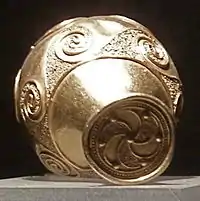Triskelion
A triskelion or triskeles is an ancient motif consisting of a triple spiral exhibiting rotational symmetry. The spiral design can be based on interlocking Archimedean spirals, or represent three bent human legs. It is found in artefacts of the European Neolithic and Bronze Age with continuation into the Iron Age especially in the context of the La Tène culture and related Celtic traditions. The actual triskeles symbol of three human legs is found especially in Greek antiquity, beginning in archaic pottery and continued in coinage of the classical period.
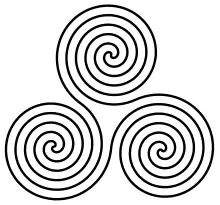
In the Hellenistic period, the symbol becomes associated with the island of Sicily, appearing on coins minted under Dionysius I of Syracuse beginning in c. 382 BC.[1] It later appears in heraldry, and, other than in the flag of Sicily, came to be used in the flag of the Isle of Man (known as ny tree cassyn "the three legs").[2]
Greek τρισκελής (triskelḗs) means "three-legged".[3] While the Greek adjective τρισκελής "three-legged [e.g. of a table]" is ancient, use of the term for the symbol is modern, introduced in 1835 by Honoré Théodoric d'Albert de Luynes as French triskèle,[4] and adopted in the spelling triskeles following Otto Olshausen (1886).[5] The form triskelion (as it were Greek τρισκέλιον[6]) is a diminutive which entered English usage in numismatics in the late 19th century.[7][8] The form consisting of three human legs (as opposed to the triple spiral) has also been called a "triquetra of legs" or triskelos, triskel.[9]
Use in European antiquity
Neolithic to Bronze Age

The triple spiral symbol, or three spiral volute, appears in many early cultures, the first in Malta (4400–3600 BC) and in the astronomical calendar at the famous megalithic tomb of Newgrange in Ireland built around 3200 BC,[10] as well as on Mycenaean vessels. The Neolithic era symbol of three conjoined spirals may have had triple significance similar to the imagery that lies behind the triskelion.[11] It is carved into the rock of a stone lozenge near the main entrance of the prehistoric Newgrange monument in County Meath, Ireland. Newgrange, which was built around 3200 BC.[10]
Classical Antiquity

The triskeles proper, composed of three human legs, is younger than the triple spiral, found in decorations on Greek pottery especially as a design shown on hoplite shields, and later also minted on Greek and Anatolian coinage. An early example is found on the shield of Achilles in an Attic hydria of the late 6th century BC.[12] It is found on coinage in Lycia, and on staters of Pamphylia (at Aspendos, 370–333 BC) and Pisidia. The meaning of the Greek triskeles is not recorded directly. The Duc de Luynes in his 1835 study noted the co-occurrence of the symbol with the eagle, the cockerel, the head of Medusa, Perseus, three crescent moons, three ears of corn, and three grains of corn . From this, he reconstructed feminine divine triad which he identified with the "triple goddess" Hecate.[4][13]
The triskeles was adopted as emblem by the rulers of Syracuse. It is possible that this usage is related with the Greek name of the island of Sicily, Trinacria (Τρινακρία "having three headlands").[14] The Sicilian triskeles is shown with the head of Medusa at the center.[15] The ancient symbol has been re-introduced in modern flags of Sicily since 1848. The oldest find of a triskeles in Sicily is a vase dated to 700 BC, for which researchers assume a Minoan-Mycenaean origin.[16]
Roman period and Late Antiquity
Late examples of the triple spiral symbols are found in Iron Age Europe, e.g. carved in rock in Castro Culture settlement in Galicia, Asturias and Northern Portugal. In Ireland before the 5th century, in Celtic Christianity the symbol took on new meaning, as a symbol of the Trinity (Father, Son, and Holy Spirit).
Medieval use
The triple spiral design is found as a decorative element in Gothic architecture. The three legs (triskeles) symbol is rarely found as a charge in late medieval heraldry, notably as the arms of the King of Mann (Armorial Wijnbergen, c. 1280), and as canting arms in the city seal of the Bavarian city of Füssen (dated 1317).
Modern usage
The triskeles was included in the design of the Army Gold Medal awarded to British Army majors and above who had taken a key part in the Battle of Maida (1806).[17] An early flag of Sicily, proposed in 1848, included the Sicilian triskeles or "Trinacria symbol". Later versions of Sicilian flags have retained the emblem, including the one officially adopted in 2000. The Flag of the Isle of Man (1932) shows a heraldic design of a triskeles of three armoured legs.
The spiral is used by some polytheistic reconstructionist or neopagan groups. As a "Celtic symbol", it is used primarily by groups with a Celtic cultural orientation and, less frequently, can also be found in use by various eclectic or syncretic traditions such as Neopaganism. The spiral triskele is one of the primary symbols of Celtic Reconstructionist Paganism, used to represent a variety of triplicities in cosmology and theology; it is also a favored symbol due to its association with the god Manannán mac Lir.[18]
Other uses of triskelion-like emblems include the logo for the Trisquel Linux distribution and the seal of the United States Department of Transportation.[19] Afrikaner Weerstandsbeweging, an Afrikaner nationalist, neo-Nazi organization and political party (founded 1973), uses a triskele composed of three sevens as its symbol.
Occurrence in nature
The boric acid molecule is triskelion-shaped as seen in the image. The molecular point group of triskelion-shaped molecules is C3h.[20][21] The endocytic protein, clathrin, is triskelion-shaped, as well as the edicaran Tribrachidium.[22]
 A molecule of boric acid
A molecule of boric acid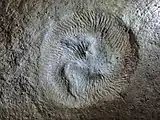 The Edicaran organism Tribrachidium
The Edicaran organism Tribrachidium
Gallery
Antiquity
Medieval
Modern
 Flag of the Isle of Man
Flag of the Isle of Man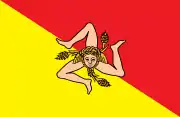 Flag of Sicily, with the triskeles-and-Gorgoneion symbol
Flag of Sicily, with the triskeles-and-Gorgoneion symbol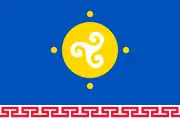 Flag of Ust-Orda Buryat Okrug
Flag of Ust-Orda Buryat Okrug Flag of Ingushetia
Flag of Ingushetia Red triskelion on the flag of Ingushetia (1994)
Red triskelion on the flag of Ingushetia (1994).svg.png.webp) Emblem of the 27th SS Volunteer Division Langemarck
Emblem of the 27th SS Volunteer Division Langemarck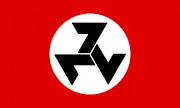 Flag of Afrikaner Weerstandsbeweging
Flag of Afrikaner Weerstandsbeweging Emblem of Afrikaner Weerstandsbeweging
Emblem of Afrikaner Weerstandsbeweging
References
- Arthur Bernard Cook, Zeus: a study in ancient religion, Volume 3, Part 2 (1940), p. 1074.
- Adopted in 1932, the flag of the Isle of Man is derived from the arms of the King of Mann recorded in the 13th century.
- τρισκελής, Henry George Liddell, Robert Scott, A Greek-English Lexicon, on Perseus Digital Library; from τρι- (tri-), "three times" (τρι- Archived 2012-10-04 at the Wayback Machine, Henry George Liddell, Robert Scott, A Greek-English Lexicon, on Perseus Digital Library) and "σκέλος" (skelos), "leg (σκέλος, Henry George Liddell, Robert Scott, A Greek–English Lexicon, on Perseus Digital Library)
- Honore-Theodoric-Paul-Joseph d'Albert de Luynes, Etudes numismatiques sur quelques types relatifs au culte d'Hecate (1835), 83f.
- Johannes Maringer, "Das Triskeles in der vor- und frühgeschichtlichen Kunst", Anthropos 74.3/4 (1979), pp. 566-576
- Classical Greek does not have *τρισκέλιον, but the form τρισκελίδιον "small tripod" is on record as the diminutive of τρισκελίς "three-pronged". The form τρισκέλιον does exist in Katharevousa, however, as the term for a small three-legged chair or table (and also of the "Rule of Three" in elementary arithmetic or generally of an analogy). Adamantios Korais, Atakta (Modern Greek Dictionary), vol. 5 (1835), p. 54.
- Barclay Vincent Head, A Guide to the Principal Gold and Silver Coins of the Ancients: From Circ. B.C. 700 to A.D. 1, British Museum. Department of Coins and Medals , The Trustees, 1881, pp. 23, 67f.
- English triskelion is recorded in 1880 (etymonline.com); the form triskele in English is occasionally found beginning in c. 1885 (e.g. in Proceedings of the Literary and Philosophical Society of Liverpool 39, 1885, p. 220), presumably as a direct representation of the French form triskèle.
- Samuel Birch, Charles Thomas Newton, A Catalogue of the Greek and Etruscan Vases in the British Museum vol. 1 (1851), p. 61. Samuel Birch, History of Ancient Pottery vol. 1 (1858), p. 164. Birch's use of triskelos is informed by the Duc de Luynes' triskèle, and it continues to see some use alongside the better-formed triskeles into the 20th century in both English and German, e.g. in a 1932 lecture by C. G. Jung (lecture of 26 October, edited in The Psychology of Kundalini Yoga: Notes of the Seminar Given in 1932. 1996, 43ff.).
- "Newgrange Ireland - Megalithic Passage Tomb - World Heritage Site". Knowth.com. 2007-12-21. Retrieved 2013-08-16.
- Anthony Murphy and Richard Moore, Island of the Setting Sun: In Search of Ireland's Ancient Astronomers, 2nd ed., Dublin: The Liffey Press, 2008, pp. 168–169
- Boston Museum of Fine Arts, illustrated in John Boardman, Jasper Griffin and Oswyn Murray, Greece and the Hellenistic World (Oxford History of the Classical World) vol. I (1988), p. 50.
- azim24 (2021-06-19). "Study : Other Religious Symbols in Islamic Art and Architecture Part 3 : The Triskelion". Stars in Symmetry. Retrieved 2022-06-09.
- Liddell and Scott’s Greek-English Lexicon (A Lexicon Abridged from), Oxford, 1944, p.27, Cassell's Latin Dictionary, Marchant, J.R.V, & Charles, Joseph F., (Eds.), Revised Edition, 1928
- Matthews, Jeff (2005) Symbols of Naples Archived 2009-10-30 at the Wayback Machine
- "Trinacria: meaning and history of the Sicilian Triskele". 12 January 2022.
- Charles Norton Elvin, A Dictionary of Heraldry (1889), p. 126.
- Bonewits, Isaac (2006) Bonewits's Essential Guide to Druidism. New York, Kensington Publishing Group ISBN 0-8065-2710-2. p. 132: [Among Celtic Reconstructionists] "...An Thríbhís Mhòr (the great triple spiral) came into common use to refer to the three realms." Also p. 134: [On CRs] "Using Celtic symbols such as triskeles and spirals"
- Kane, Robert M. (1 January 2019). Air Transportation. Kendall Hunt. ISBN 9780787288815 – via Google Books.
- Greenwood, Norman N.; Earnshaw, Alan (1997). Chemistry of the Elements (2nd ed.). Butterworth-Heinemann. p. 1291. ISBN 978-0-08-037941-8.
- Housecroft, C. E.; Sharpe, A. G. (2008). Inorganic Chemistry (3rd ed.). Prentice Hall. pp. 94–99. ISBN 978-0-13-175553-6.
- "InterPro".



